Yamaha P155 User Manual

D I G I T A L P I A N O
P I A N O N U M E R I Q U E
Owner’s Manual
Bedienungsanleitung
Mode d’emploi
Manual de instrucciones
ENGLISH
DEUTSCH
FRANÇAIS
ESPAÑOL
EN
DE
FR
ES

SPECIAL MESSAGE SECTION
This product utilizes batteries or an external power supply (adapter). DO NOT connect this product to any power supply or adapter other than one described in the manual, on the name plate, or specifically recommended by Yamaha.
WARNING: Do not place this product in a position where anyone could walk on, trip over, or roll anything over power or connecting cords of any kind. The use of an extension cord is not recommended! If you must use an extension cord, the minimum wire size for a 25’ cord (or less ) is 18 AWG. NOTE: The smaller the AWG number, the larger the current handling capacity. For longer extension cords, consult a local electrician.
This product should be used only with the components supplied or; a cart, rack, or stand that is recommended by Yamaha. If a cart, etc., is used, please observe all safety markings and instructions that accompany the accessory product.
SPECIFICATIONS SUBJECT TO CHANGE:
The information contained in this manual is believed to be correct at the time of printing. However, Yamaha reserves the right to change or modify any of the specifications without notice or obligation to update existing units.
This product, either alone or in combination with an amplifier and headphones or speaker/s, may be capable of producing sound levels that could cause permanent hearing loss. DO NOT operate for long periods of time at a high volume level or at a level that is uncomfortable. If you experience any hearing loss or ringing in the ears, you should consult an audiologist.
IMPORTANT: The louder the sound, the shorter the time period before damage occurs.
Some Yamaha products may have benches and / or accessory mounting fixtures that are either supplied with the product or as optional accessories. Some of these items are designed to be dealer assembled or installed. Please make sure that benches are stable and any optional fixtures (where applicable) are well secured BEFORE using. Benches supplied by Yamaha are designed for seating only. No other uses are recommended.
NOTICE:
Service charges incurred due to a lack of knowledge relating to how a function or effect works (when the unit is operating as designed) are not covered by the manufacturer’s warranty, and are therefore the owners responsibility. Please study this manual carefully and consult your dealer before requesting service.
ENVIRONMENTAL ISSUES:
Battery Notice:
This product MAY contain a small non-rechargeable battery which (if applicable) is soldered in place. The average life span of this type of battery is approximately five years. When replacement becomes necessary, contact a qualified service representative to perform the replacement.
This product may also use “household” type batteries. Some of these may be rechargeable. Make sure that the battery being charged is a rechargeable type and that the charger is intended for the battery being charged.
When installing batteries, do not mix batteries with new, or with batteries of a different type. Batteries MUST be installed correctly. Mismatches or incorrect installation may result in overheating and battery case rupture.
Warning:
Do not attempt to disassemble, or incinerate any battery. Keep all batteries away from children. Dispose of used batteries promptly and as regulated by the laws in your area. Note: Check with any retailer of household type batteries in your area for battery disposal information.
Disposal Notice:
Should this product become damaged beyond repair, or for some reason its useful life is considered to be at an end, please observe all local, state, and federal regulations that relate to the disposal of products that contain lead, batteries, plastics, etc. If your dealer is unable to assist you, please contact Yamaha directly.
NAME PLATE LOCATION:
The name plate is located on the bottom of the product. The model number, serial number, power requirements, etc., are located on this plate. You should record the model number, serial number, and the date of purchase in the spaces provided below and retain this manual as a permanent record of your purchase.
Model
Serial No.
Purchase Date
Yamaha strives to produce products that are both user safe and environmentally friendly. We sincerely believe that our products and the production methods used to produce them, meet these goals. In keeping with both the letter and the spirit of the law, we want you to be aware of the following:
PLEASE KEEP THIS MANUAL
92-BP (bottom)
2 |
P-155 Owner’s Manual |
|
|

FCC INFORMATION (U.S.A.) |
|
||
1. IMPORTANT NOTICE: DO NOT MODIFY THIS UNIT! |
interference will not occur in all installations. If this product |
||
This product, when installed as indicated in the instruc- |
is found to be the source of interference, which can be |
||
tions contained in this manual, meets FCC requirements. |
determined by turning the unit “OFF” and “ON”, please try |
||
Modifications not expressly approved by Yamaha may void |
to eliminate the problem by using one of the following |
||
your authority, granted by the FCC, to use the product. |
measures: |
|
|
2. IMPORTANT: When connecting this product to accesso- |
Relocate either this product or the device that is being |
||
ries and/or another product use only high quality shielded |
affected by the interference. |
|
|
cables. Cable/s supplied with this product MUST be used. |
Utilize power outlets that are on different branch (circuit |
||
Follow all installation instructions. Failure to follow instruc- |
|||
breaker or fuse) circuits or install AC line filter/s. |
|
||
tions could void your FCC authorization to use this prod- |
|
||
In the case of radio or TV interference, relocate/reorient |
|||
uct in the USA. |
|||
the antenna. If the antenna lead-in is 300 ohm ribbon |
|||
3. NOTE: This product has been tested and found to com- |
|||
lead, change the lead-in to co-axial type cable. |
|
||
ply with the requirements listed in FCC Regulations, Part |
|
||
If these corrective measures do not produce satisfactory |
|||
15 for Class “B” digital devices. Compliance with these |
|||
results, please contact the local retailer authorized to dis- |
|||
requirements provides a reasonable level of assurance |
|||
tribute this type of product. If you can not locate the appro- |
|||
that your use of this product in a residential environment |
|||
priate retailer, please contact Yamaha Corporation of |
|
||
will not result in harmful interference with other electronic |
|
||
America, Electronic Service Division, 6600 Orangethorpe |
|||
devices. This equipment generates/uses radio frequen- |
|||
Ave, Buena Park, CA90620 |
|
||
cies and, if not installed and used according to the instruc- |
|
||
|
|
||
tions found in the users manual, may cause interference |
The above statements apply ONLY to those products dis- |
||
harmful to the operation of other electronic devices. Com- |
tributed by Yamaha Corporation of America or its subsid- |
||
pliance with FCC regulations does not guarantee that |
iaries. |
|
|
|
|
||
* This applies only to products distributed by YAMAHA CORPORATION OF AMERICA. |
(class B) |
||
OBSERVERA!
Apparaten kopplas inte ur växelströmskällan (nätet) så länge som den ar ansluten till vägguttaget, även om själva apparaten har stängts av.
ADVARSEL: Netspæendingen til dette apparat er IKKE afbrudt, sålæenge netledningen siddr i en stikkontakt, som er t endt — også selvom der or slukket på apparatets afbryder.
VAROITUS: Laitteen toisiopiiriin kytketty käyttökytkin ei irroita koko laitetta verkosta.
(standby)
IMPORTANT NOTICE FOR THE UNITED KINGDOM
Connecting the Plug and Cord
IMPORTANT. The wires in this mains lead are coloured in accordance with the following code:
BLUE : NEUTRAL
BROWN : LIVE
As the colours of the wires in the mains lead of this apparatus may not correspond with the coloured makings identifying the terminals in your plug proceed as follows:
The wire which is coloured BLUE must be connected to the terminal which is marked with the letter N or coloured BLACK.
The wire which is coloured BROWN must be connected to the terminal which is marked with the letter L or coloured RED.
Making sure that neither core is connected to the earth terminal of the three pin plug.
• This applies only to products distributed |
(2 wires) |
by Yamaha Music U.K. Ltd. |
|
P-155 Owner’s Manual |
3 |
|
|

ENGLISH
PRECAUTIONS
PLEASE READ CAREFULLY BEFORE PROCEEDING
* Please keep this manual in a safe place for future reference.
 WARNING
WARNING
Always follow the basic precautions listed below to avoid the possibility of serious injury or even death from electrical shock, short-circuiting, damages, fire or other hazards. These precautions include, but are not limited to, the following:
Power supply/AC power adaptor |
|
Water warning |
•Only use the voltage specified as correct for the instrument. The required voltage is printed on the name plate of the instrument.
•Use the specified adaptor (PA-301, PA-300B, or an equivalent recommended by Yamaha) only. Using the wrong adaptor can result in damage to the instrument or overheating.
•Check the electric plug periodically and remove any dirt or dust which may have accumulated on it.
•Do not place the AC adaptor cord near heat sources such as heaters or radiators, and do not excessively bend or otherwise damage the cord, place heavy objects on it, or place it in a position where anyone could walk on, trip over, or roll anything over it.
•Do not expose the instrument to rain, use it near water or in damp or wet conditions, or place containers on it containing liquids which might spill into any openings. If any liquid such as water seeps into the instrument, turn off the power immediately and unplug the power cord from the AC outlet. Then have the instrument inspected by qualified Yamaha service personnel.
•Never insert or remove an electric plug with wet hands.
Fire warning
•Do not put burning items, such as candles, on the unit. A burning item may fall over and cause a fire.
|
|
|
|
If you notice any abnormality |
|
|
|
Do not open |
|
• If the AC adaptor cord or plug becomes frayed or damaged, or if there is a |
|||
• Do not open the instrument or attempt to disassemble the internal parts or |
||||||
|
sudden loss of sound during use of the instrument, or if any unusual smells or |
|||||
|
modify them in any way. The instrument contains no user-serviceable parts. If it |
|
||||
|
|
smoke should appear to be caused by it, immediately turn off the power switch, |
||||
|
should appear to be malfunctioning, discontinue use immediately and have it |
|
||||
|
|
disconnect the adaptor plug from the outlet, and have the instrument inspected |
||||
|
inspected by qualified Yamaha service personnel. |
|
||||
|
|
by qualified Yamaha service personnel. |
||||
|
|
|
|
|||
 CAUTION
CAUTION
Always follow the basic precautions listed below to avoid the possibility of physical injury to you or others, or damage to the instrument or other property. These precautions include, but are not limited to, the following:
|
|
|
Power supply/AC power adaptor |
Location |
•When removing the electric plug from the instrument or an outlet, always hold the plug itself and not the cord.
•Unplug the AC power adaptor when not using the instrument, or during electrical storms.
•Do not connect the instrument to an electrical outlet using a multiple-connector. Doing so can result in lower sound quality, or possibly cause overheating in the outlet.
•Do not expose the instrument to excessive dust or vibrations, or extreme cold or heat (such as in direct sunlight, near a heater, or in a car during the day) to prevent the possibility of panel disfiguration or damage to the internal components.
•Do not use the instrument in the vicinity of a TV, radio, stereo equipment, mobile phone, or other electric devices. Otherwise, the instrument, TV, or radio may generate noise.
•Do not place the instrument in an unstable position where it might accidentally fall over.
•Before moving the instrument, remove all connected adaptor and other cables.
•When setting up the product, make sure that the AC outlet you are using is easily accessible. If some trouble or malfunction occurs, immediately turn off the power switch and disconnect the plug from the outlet. Even when the power switch is turned off, electricity is still flowing to the product at the minimum level. When you are not using the product for a long time, make sure to unplug the power cord from the wall AC outlet.
•Use only the stand specified for the instrument. When attaching the stand or rack, use the provided screws only. Failure to do so could cause damage to the internal components or result in the instrument falling over.
(3)-12 1/2
4 |
P-155 Owner’s Manual |
|
|
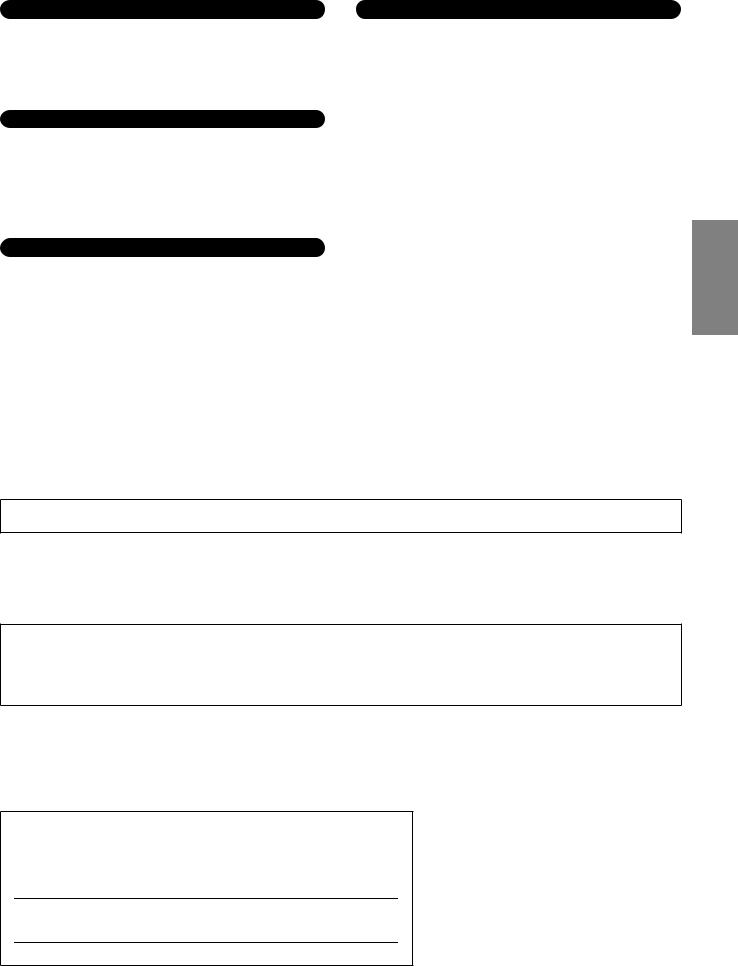
|
|
|
|
|
|
Connections |
Saving data |
||||
• Before connecting the instrument to other electronic components, turn off the |
Saving and backing up your data |
||||
|
power for all components. Before turning the power on or off for all |
• Data in the instrument’s internal memory can be lost due to operational errors or |
|||
|
components, set all volume levels to minimum. Also, be sure to set the volumes |
||||
|
|
malfunction. Be sure to save any important data to external media via a |
|||
|
of all components at their minimum levels and gradually raise the volume |
|
|||
|
|
computer connected to the instrument. (page 52) |
|||
|
controls while playing the instrument to set the desired listening level. |
|
|||
|
|
|
|
||
|
|
|
Backing up the USB Storage device |
||
|
Maintenance |
|
|||
|
|
|
|
|
|
•When cleaning the instrument, use a soft, dry cloth. Do not use paint thinners, solvents, cleaning fluids, or chemical-impregnated wiping cloths.
•During extreme changes in temperature or humidity, condensation may occur and water may collect on the surface of the instrument. If water is left, the wooden parts may absorb the water and be damaged. Make sure to wipe any water off immediately with a soft cloth.
Handling caution
•Do not insert a finger or hand in any gaps on the instrument.
•Never insert or drop paper, metallic, or other objects into the gaps on the panel or keyboard. If this happens, turn off the power immediately and unplug the power cord from the AC outlet. Then have the instrument inspected by qualified Yamaha service personnel.
•Do not place vinyl, plastic or rubber objects on the instrument, since this might discolor the panel or keyboard.
•Do not rest your weight on, or place heavy objects on the instrument, and do not use excessive force on the buttons, switches or connectors.
•Do not use the instrument/device or headphones for a long period of time at a high or uncomfortable volume level, since this can cause permanent hearing loss. If you experience any hearing loss or ringing in the ears, consult a physician.
•To protect against data loss through media damage, we recommend that you save your important data onto two USB storage devices.
Yamaha cannot be held responsible for damage caused by improper use or modifications to the instrument, or data that is lost or destroyed.
Always turn the power off when the instrument is not in use.
Even when the power switch is in the “STANDBY” position, electricity is still flowing to the instrument at the minimum level. When you are not using the instrument for a long time, make sure you unplug the AC power adaptor from the wall AC outlet.
This product incorporates and bundles computer programs and contents in which Yamaha owns copyrights or with respect to which it has license to use others’ copyrights. Such copyrighted materials include, without limitation, all computer software, style files, MIDI files, WAVE data, musical scores and sound recordings. Any unauthorized use of such programs and contents outside of personal use is not permitted under relevant laws. Any violation of copyright has legal consequences. DON’T MAKE, DISTRIBUTE OR USE ILLEGAL COPIES.
•Copying of the commercially available musical data including but not limited to MIDI data and/or audio data is strictly prohibited except for your personal use.
•Windows is a registered trademark of Microsoft® Corporation in the United States and other countries.
•The company names and product names in this manual are the trademarks or registered trademarks of their respective companies.
The serial number of this product may be found on the bottom of the unit. You should note this serial number in the space provided below and retain this manual as a permanent record of your purchase to aid identification in the event of theft.
Model No.
Serial No.
(bottom)
(3)-12 2/2
ENGLISH
P-155 Owner’s Manual |
5 |
|
|

ENGLISH
Introduction
Thank you for purchasing the Yamaha Digital Piano!
We recommend that you read this manual carefully so that you can fully take advantage of the advanced and convenient functions.
We also recommend that you keep this manual in a safe and handy place for future reference.
Main Features
 Graded Hammer Effect Keyboard
Graded Hammer Effect Keyboard
Thanks to our experience as the world’s leading manufacturer of acoustic pianos, we’ve developed a keyboard with action that’s virtually indistinguishable from the real thing. Just as on a traditional acoustic piano, the keys of the lower notes have a heavier touch, while the higher ones are more responsive to lighter playing. The keyboard’s sensitivity can even be adjusted to match your playing style.
 AWM Dynamic Stereo Sampling
AWM Dynamic Stereo Sampling
This digital piano offers a rich and versatile range of sounds, which are created using Yamaha’s proprietary sampling tone-generation system, “AWM Dynamic Stereo Sampling.”
AWM (Advanced Wave Memory) is a sampling system that creates sounds close to those of an acoustic instrument by digitally recording the sounds of an instrument and applying high-quality digital filtering technology to the recorded audio samples.
The sound waveform created by an acoustic piano differs depending on the player’s strength of touch, from pianissimo to fortissimo.
AWM Dynamic Stereo Sampling can create extremely dynamic nuances by recording samples at various playing strengths. The greater the number of samples used, the greater the resulting expressiveness of the instrument.
The piano voice “Grand Piano 1” features a totally new sample recorded from a full-size concert grand piano. Each note in the sample has been adjusted meticulously so that the digital piano will play only the very best piano sounds. The piano voices are well-separated sounds featuring a fast attack and a satisfying response.
The “Grand Piano 1” voice features multiple wave samples for different velocities (Dynamic Sampling). That is, different samples are used depending on how fast or strong the player strikes the keys. Therefore, this voice expresses detailed dynamics and sounds much closer to those of a true acoustic piano.
The instrument creates a rich, luxurious sound using “Sustain Sampling,” which is a sample of the soundboard and the resonance of the strings when the damper pedal is pressed. The instrument also features “Key-off Sampling,” which is a sample of the very delicate noises that are caused when keys are released.
Accessories
•Owner’s Manual
•Yamaha PA-301 Power Adaptor* (not for sale)
*May not be included depending on your particular area. Please check with your Yamaha dealer.
•Foot Switch FC4
•Music Rest
•My Yamaha Product User Registration*
*The PRODUCT ID on the sheet will be needed when you fill out the User Registration form.
6 |
P-155 Owner’s Manual |
|
|

Table of Contents
This manual consists of three main sections: Introduction, Reference and Appendix.
Introduction |
|
Please read this section first. |
|
Main Features..................................................... |
6 |
Accessories ......................................................... |
6 |
Panel Controls and Terminals............................ |
8 |
Before Using the Instrument ........................... |
10 |
Turning the Power On ............................................... |
10 |
Setting the Volume ..................................................... |
10 |
Using the Pedals.......................................................... |
11 |
Using Headphones ..................................................... |
11 |
Music Rest................................................................... |
11 |
Reference
This section explains in detail all of the instrument’s features, functions and operations.
Listening to the Demo Songs .......................... |
12 |
Using the 50 Piano “Preset” Songs ................. |
13 |
Listening to the 50 Piano Preset Songs...................... |
13 |
Practicing a One-Hand Part Using |
|
the 50 Preset Songs (Part Cancel Function) ........... |
14 |
A-B Repeat for the 50 Preset Songs ........................... |
15 |
Selecting & Playing Voices............................... |
16 |
Selecting Voices .......................................................... |
16 |
Combining Voices (Dual).......................................... |
17 |
Splitting the Keyboard Range and |
|
Playing Two Different Voices ([SPLIT]) ................ |
18 |
Adding Variations to the Sound – |
|
[BRILLIANCE]/[REVERB]/ |
|
[EFFECT]/“Damper Resonance” ............................ |
20 |
Touch Sensitivity – [TOUCH] .................................. |
22 |
Transposition – [TRANSPOSE] ................................ |
23 |
Using the Metronome ................................................ |
24 |
Recording Your Performance .......................... |
25 |
Recording a performance quickly.............................. |
25 |
Re-recording a previously recorded song.................. |
27 |
Recording to RIGHT/LEFT ....................................... |
28 |
Changing the Initial Settings |
|
(data recorded at the beginning of a song) ............. |
30 |
Handling Recorded Songs with |
|
a USB Storage Device....................................... |
31 |
About Save and Load.................................................. |
31 |
Saving a Song .............................................................. |
32 |
Loading a Song ........................................................... |
33 |
Deleting Song Files ..................................................... |
34 |
Formatting the USB Storage Device .......................... |
35 |
Playing Back “USER” and “USB” Songs ........... |
36 |
Detailed Settings – [FUNCTION]...................... |
38 |
Basic Procedure in Function...................................... |
39 |
About Each Function ................................................. |
40 |
F1. Fine Tuning of the Pitch ............................... |
40 |
F2. Selecting a Scale............................................. |
40 |
F3. Dual Functions .............................................. |
41 |
F4. Split Functions............................................... |
42 |
F5. Other Functions ............................................ |
43 |
F6. Metronome Volume ..................................... |
44 |
F7. MIDI Functions............................................. |
44 |
F8. Backup Functions.......................................... |
46 |
Connections ..................................................... |
47 |
Connectors.................................................................. |
47 |
Connecting to a USB storage device.......................... |
49 |
Connecting a Personal Computer ............................. |
50 |
Transmitting Song Data between |
|
the Computer and the Instrument.......................... |
51 |
Data Backup Using a Computer....................... |
52 |
Precautions when using |
|
the USB [TO DEVICE] terminal......................... |
53 |
Using USB Storage Devices........................................ |
53 |
Handling the Floppy Disk Drive (FDD) and |
|
Floppy Disks (Optional) ................................... |
54 |
Message List ..................................................... |
55 |
Troubleshooting............................................... |
56 |
Preset Voice List ............................................... |
57 |
Index................................................................. |
58 |
Appendix |
|
This section introduces reference material. |
|
Preset Song List................................................ |
60 |
Factory Setting List .......................................... |
61 |
MIDI Data Format ............................................ |
62 |
MIDI Implementation Chart ............................ |
66 |
Specifications ................................................... |
68 |
*The illustrations and displays as shown in this owner’s manual are for instructional purposes only, and may appear somewhat different from those on your instrument.
ENGLISH
P-155 Owner’s Manual |
7 |
|
|
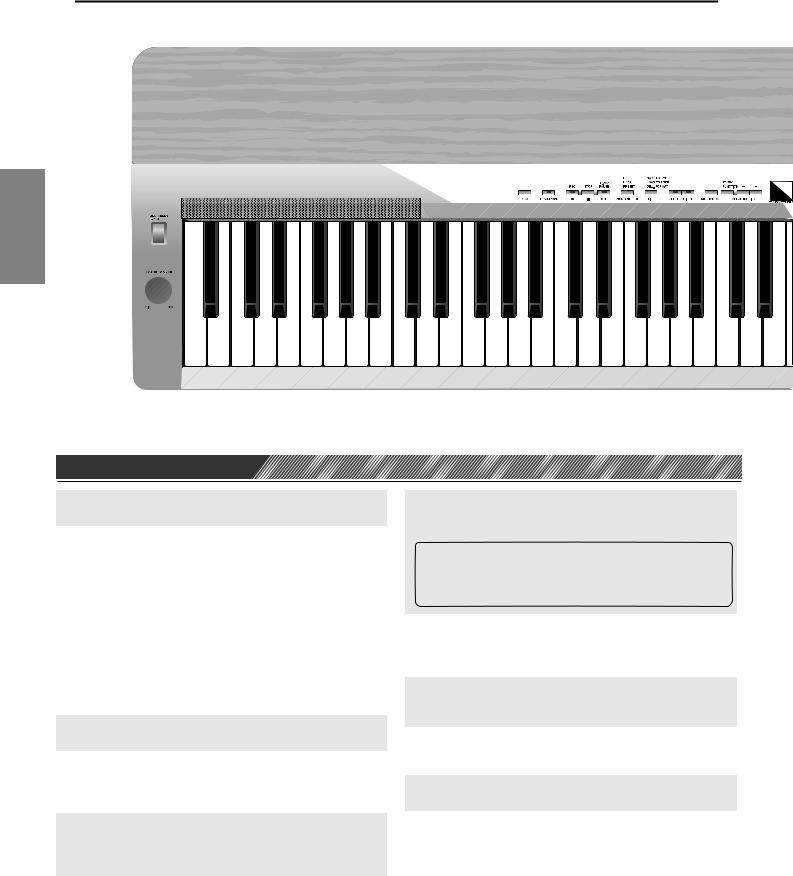
Panel Controls and Terminals
Panel Controls and Terminals
q |
e r t y u i o !0 !1 !2 |
ENGLISH
w
A-1 B-1 C0 D0 E0 F0 G0 A0 B0 C1 D1 E1 F1 G1 A1 B1 C2 D2 E2 F2 G2 A2 B2 C3 D3 E3
Front panel
q [STANDBY/ON] switch |
page 10 |
For turning the power on or off.
w [MASTER VOLUME] dial |
page 10 |
For adjusting the volume level of the entire sound.
e [DEMO] button |
page 12 |
For playing the demo songs. |
|
r [TRANSPOSE] button |
page 23 |
For shifting the pitch of the entire keyboard up or down.
t [REC] button |
page |
25 |
For recording your keyboard performance. |
|
|
y [PLAY/PAUSE], [STOP] buttons |
pages 13, |
37 |
For playing back/pausing/stopping the preset songs, your recorded material or commercially available music data, etc.
u [SONG SELECT] button |
pages 13, 37 |
For selecting a song to play back or edit.
i [FILE] button |
page 32 |
For saving songs to and loading songs from a USB storage device, as well as managing song files. Also, lets you format a USB storage device.
o [RIGHT], [LEFT] buttons |
pages 14, 37 |
For turning the leftand right-hand parts on or off as required so you can practice the corresponding part (the part that is turned off) on the keyboard.
!0[METRONOME] button |
pages 24, 44 |
For starting/stopping the metronome function.
!2Display |
page 10 |
For showing information on certain settings and values of the instrument.
 CAUTION
CAUTION
Never attempt to turn off the power while flashing dashes appear in the display, indicating data is being written to internal memory. Doing so may result in loss of all user data.
!3[–/NO], [+/YES] buttons
For setting values or performing file operations.
Pressing both buttons simultaneously for certain value settings (Transpose, Tempo, etc.) restores the default value.
!4Voice group buttons |
page 16 |
For selecting voices from 17 internal sounds including Grand Piano 1, 2 and 3.
!5[SPLIT] button |
page 18 |
For playing different voices on the leftand righthand sections of the keyboard.
!6[BRILLIANCE] button |
page 20 |
For adjusting the brightness of the sound.
!7[REVERB], [EFFECT] buttons |
pages 20, 21 |
For adding reverb and chorus effects to the selected voice for your keyboard performance.
!8[TOUCH] button |
page 22 |
For selecting the touch response. |
|
!9[PHONES] jack |
page 11 |
|
|
!1[TEMPO/FUNCTION –, +] button |
pages 24, 39 |
For connecting a set of standard stereo headphones, allowing |
|
|
For changing the song tempo (speed) and selecting other useful |
private practice. |
|
|
|
functions (pages 38–46). |
|
|
|
|
|
|
|
8 |
P-155 Owner’s Manual |
|
|
|
|
|
|
|
|
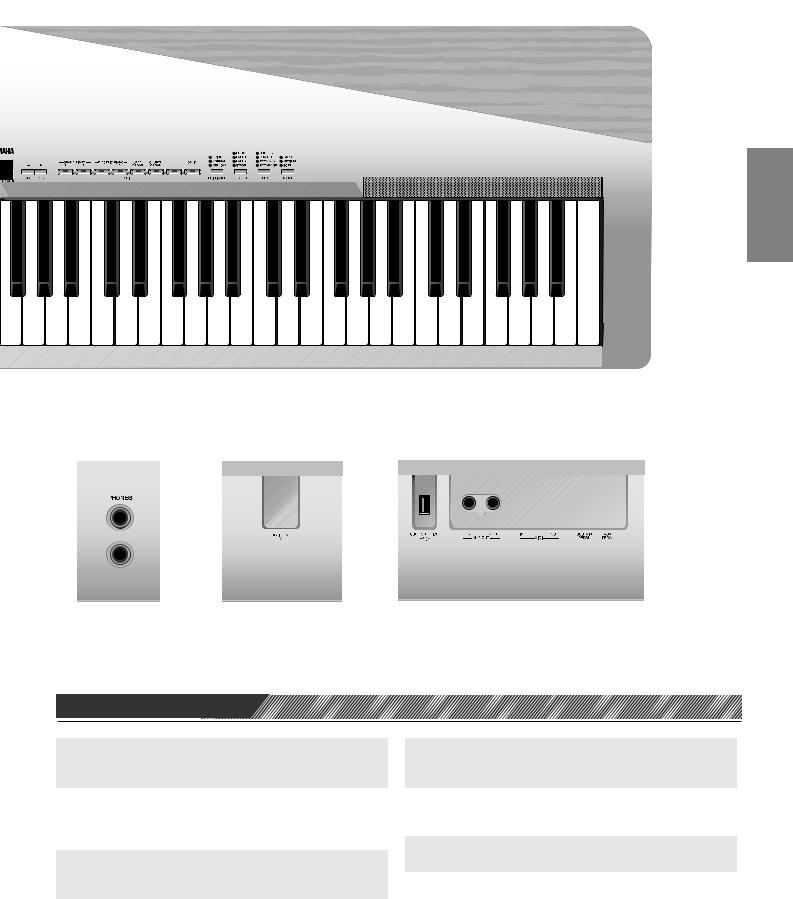
Panel Controls and Terminals
!3 |
!4 |
!5!6 !7 !8 |
ENGLISH
F3 |
G3 |
A3 |
B3 |
C4 |
D4 |
E4 |
F4 |
G4 |
A4 |
B4 |
C5 |
D5 |
E5 |
F5 |
G5 |
A5 |
B5 |
C6 |
D6 |
E6 |
F6 |
G6 |
A6 |
B6 |
C7 |
!9
@5 |
@0 |
@1 |
@2 |
@3@4 |
Rear panel
@0USB [TO DEVICE] terminal |
page 47 |
For connecting the instrument to a USB storage device, allowing saving/loading of data to and from the connected device.
@1AUX OUT [L/L+R][R] jacks |
page 47 |
For connecting an external tone generator, allowing you to play the sound of that device via the instrument’s internal sound system and speakers.
@2MIDI [IN] [OUT] terminals |
page 48 |
For connecting external MIDI devices, allowing the use of various MIDI functions.
@3[SUSTAIN PEDAL] jack |
pages 11, 48 |
For connecting an included FC4 foot switch or an optional FC3 foot pedal/FC5 foot switch.
@4[AUX PEDAL] jack |
pages 11, 48 |
For connecting an included FC4 foot switch or an optional FC3 foot pedal/FC5 foot switch/FC7 foot controller.
@5[DC IN 16V] jack |
page 10 |
For connecting the included power adaptor.
P-155 Owner’s Manual |
9 |
|
|
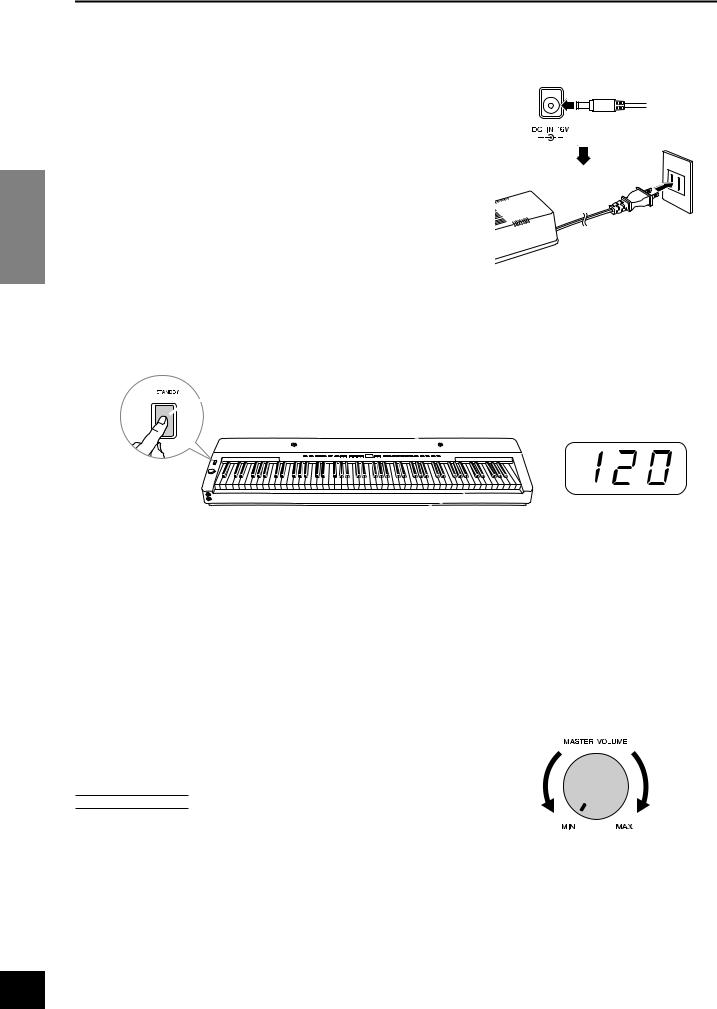
ENGLISH
Before Using the Instrument
Before Using the Instrument
 Turning the Power On
Turning the Power On
1. Connect the power adaptor’s DC cable to the [DC IN 16V] jack.
2. Plug the AC adaptor into an AC outlet.
 WARNING
WARNING
Use the specified adaptor (PA-301, PA-300B or an equivalent recommended by Yamaha) only. The use of other adaptors may result in irreparable damage to both the adaptor and the Instrument.
 CAUTION
CAUTION
(The shape of plug differs depending on locale.)
Unplug the AC Power Adaptor when not using the Instrument, or during electrical storms.
3. Press the [STANDBY/ON] switch to turn the power on.

 [STANDBY/ON] switch
[STANDBY/ON] switch
Display
Normally indicates tempo.
The display located in the center of the front panel lights up.
When you’re ready to turn off the power, press the [STANDBY/ON] switch again.
 CAUTION
CAUTION
Even when the instrument is turned off, electricity is still flowing to the instrument at the minimum level. When you are not using the instrument for a long time, make sure you unplug the AC power adaptor from the wall AC outlet.
 Setting the Volume
Setting the Volume
Initially set the [MASTER VOLUME] dial about halfway between the “MIN” and “MAX” settings. Then, when you start playing, re-adjust the [MASTER VOLUME] dial to the most comfortable listening level.
The level |
The level |
decreases. |
increases. |
TERMINOLOGY MASTER VOLUME:
The volume level of the entire keyboard sound
P-155 Owner’s Manual
10

 Using the Pedals
Using the Pedals
FC4
Sustain Pedal (Sustain Pedal jack)
This jack is for connecting the included foot switch FC4. The pedal functions in the same way as a damper pedal on an acoustic piano. Connect the included foot switch FC4 to this jack and press the pedal to sustain the sound.
When “Damper Resonance” is on, the instrument simulates the sustain sound that occurs when you press the damper pedal of a grand piano, as you press the damper pedal and play the keyboard.
An optional FC3 foot pedal or FC5 foot switch can also be connected to this jack. For the FC3, the further down the pedal is pressed, the longer the sound will be sustained. (It can be used like a half pedal effect).
•The depth of the effect produced by the Sustain Samples can be adjusted via the Pedal functions (pages 39, 43) in Function.
AUX Pedal (AUX Pedal jack)
This jack is for connecting an optional FC3 foot pedal, FC5 foot switch or FC7 foot controller. An included foot switch FC4 can also be connected to this jack. A wide range of functions, including the Soft Pedal function, can be assigned to this jack. For instructions on assigning the pedal, refer to pages 39, 43.
• The FC7 Foot Controller can be used to control Expression (pages 39, 43).
Before Using the Instrument
 NOTE
NOTE
If the sustain pedal doesn’t work, make sure that the pedal cord is properly plugged into the jack.
TERMINOLOGY
Half-pedal:
While playing the piano with Sustain and you want to slightly mute the sustained sound, release the pedal from maximum position to half position.
 Using Headphones
Using Headphones
Connect a set of headphones to one of the [PHONES] jacks. Two [PHONES] jacks are provided.
You can connect two sets of standard stereo headphones. (If you are using only one set of headphones, you can plug them into either jack.)
 CAUTION
CAUTION
Do not use the instrument at a high volume level for a long period of time, or your hearing may be damaged.
 CAUTION
CAUTION
The speakers are automatically shut off when a plug is inserted into this jack.
•Optional headphones: HPE-150 Yamaha headphones
 Music Rest
Music Rest
The instrument includes a music rest that can be attached to the instrument by inserting it into the holes at the top of the control panel.
On front panel
Standard stereo phone plug
ENGLISH
P-155 Owner’s Manual
11
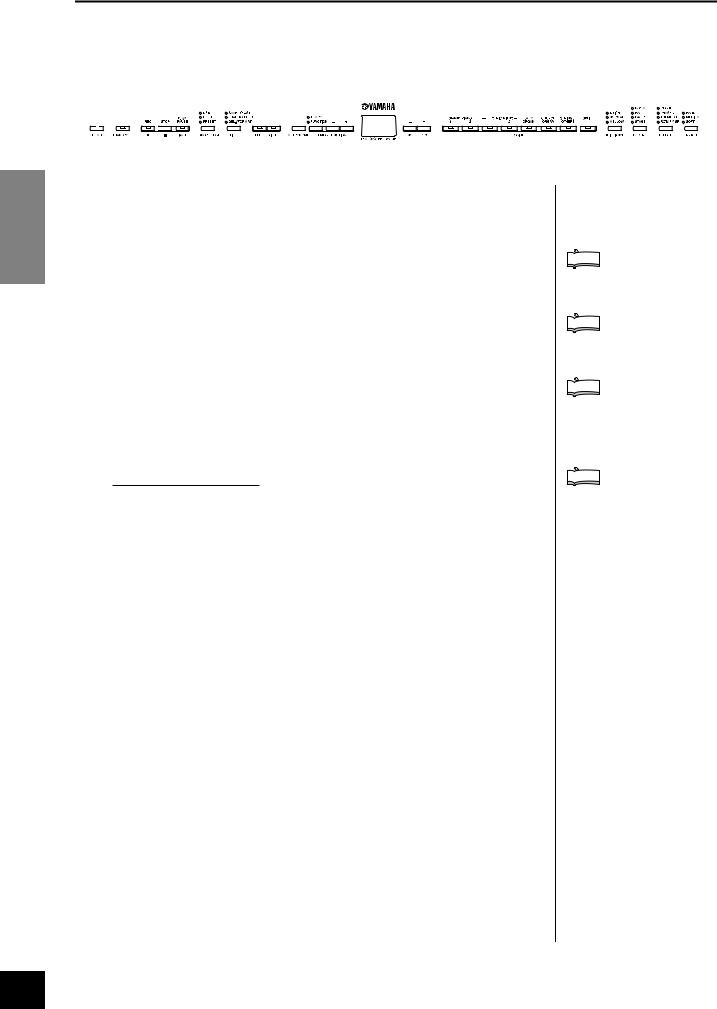
Reference
Listening to the Demo Songs
Listening to the Demo Songs
Demo songs are provided that effectively demonstrate each of the instrument’s voices.
3 |
4 |
4 |
|
|
3 |
|
|||||||
|
|
|
|
|
|
|
|
|
|
|
|
|
|
|
|
|
|
|
|
|
|
|
|
|
|
|
|
|
|
|
|
|
|
|
|
|
|
|
|
|
|
|
|
|
|
|
|
|
|
|
|
|
|
|
|
|
|
|
|
|
|
|
|
|
|
|
|
|
|
|
|
|
|
|
|
|
|
|
|
|
|
|
|
|
|
|
|
|
|
|
|
|
|
|
|
|
|
ENGLISH
1. Press the [STANDBY/ON] switch to turn the power on (page 10).
When the power is turned ON, one of the voice button indicators will light.
2. Adjust the volume (page 10).
Initially set the [MASTER VOLUME] dial about half way between the “MIN” and “MAX” settings. Then, when you start playing, re-adjust the [MASTER VOLUME] dial to the most comfortable listening level.
3. Press the [DEMO] button to listen to the Demo songs.
The VOICE button indicators will flash in sequence, then the GRAND PIANO 1 demo song will start. Demo songs provided for each voice will play back in sequence until you press the [DEMO] or [STOP] button.
Changing a demo song
You can change to another Demo song during playback by pressing the desired VOICE button.
Demo Song List
Voice Name |
Title |
Composer |
|
GRAND PIANO 1 |
Original |
Original |
|
|
|
|
|
GRAND PIANO 2 |
Original |
Original |
|
|
|
|
|
ELECTRIC PIANO 1 |
Original |
Original |
|
|
|
|
|
ELECTRIC PIANO 2 |
Original |
Original |
|
|
|
|
|
JAZZ ORGAN |
Original |
Original |
|
|
|
|
|
CHURCH ORGAN |
Herr Christ, der ein’ge Gottes- |
J. S. Bach |
|
Sohn, BWV.601 |
|||
|
|
||
|
|
|
|
STRINGS 1 |
Original |
Original |
|
([STRINGS/OTHERS] o 1) |
|||
|
|
||
|
|
|
•The demonstration song of CHURCH ORGAN features short rearranged excerpts of the original composition.
•All songs except CHURCH ORGAN are original (© 2008 Yamaha Corporation).
4.Press the [DEMO] or [STOP] button to stop the Voice demo.
 NOTE
NOTE
Demo song data is not transmitted via the MIDI terminals.
 NOTE
NOTE
MIDI reception is not possible during Demo song playback.
 NOTE
NOTE
Demo songs cannot be played during song recording (page 25) or in the File Operation mode (page 39).
 NOTE
NOTE
You cannot adjust the tempo of demo songs.
You cannot use the Part Cancel function (page 14) or the Song A-B Repeat function (page 15) in Demo.
12 P-155 Owner’s Manual
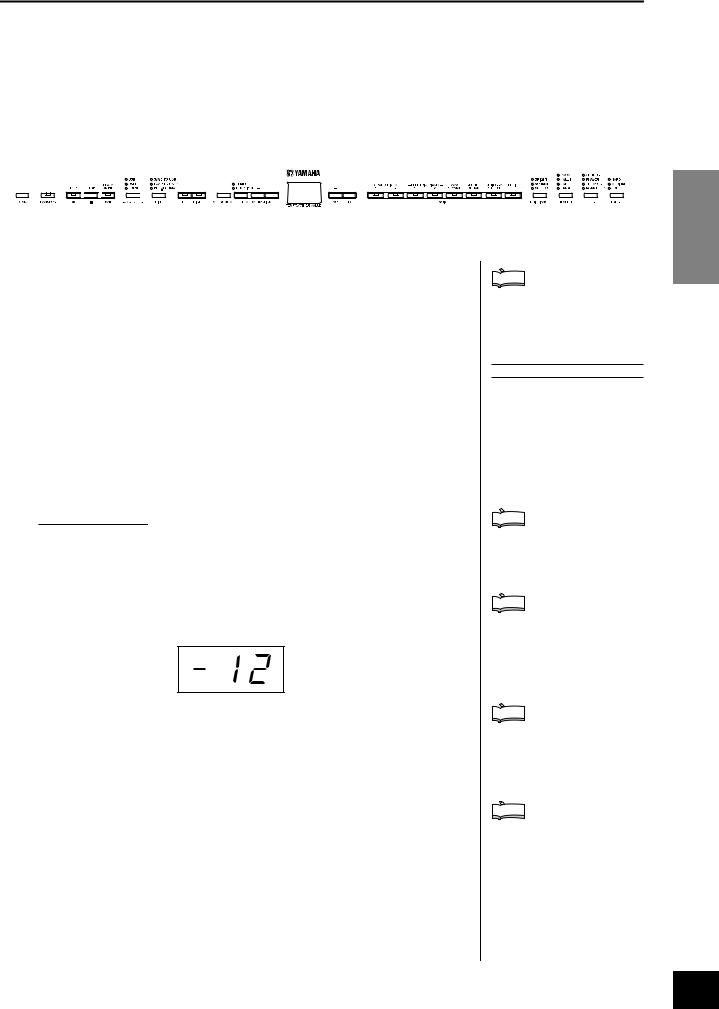
Using the 50 Piano “Preset” Songs
Using the 50 Piano “Preset” Songs
 Listening to the 50 Piano Preset Songs
Listening to the 50 Piano Preset Songs
The instrument provides performance data of 50 piano songs. You can simply listen to these songs (page 60) or use them for practice (page 14).
4 |
3 |
1 5 |
2 |
|
|
|
|
|
|||||||
|
|
|
|
|
|
|
|
|
|
|
|
|
|
|
|
|
|
|
|
|
|
|
|
|
|
|
|
|
|
|
|
|
|
|
|
|
|
|
|
|
|
|
|
|
|
|
|
|
|
|
|
|
|
|
|
|
|
|
|
|
|
|
|
|
|
|
|
|
|
|
|
|
|
|
|
|
|
|
|
|
|
|
|
|
|
|
|
|
|
|
|
|
|
|
|
1. Press the [SONG SELECT] button a few times until the “PRESET” indicator lights.
2. Press the [–/NO], [+/YES] buttons to select the number of the tune you want to play.
The number will appear on the display.
1–50: Select a preset song number and play only the song. ALL: Play all preset songs in sequence.
rnd: Play all preset songs continuously in random order.
3. Press the [PLAY/PAUSE] button to start playback.
Adjust the tempo
You can use the [TEMPO/FUNCTION –, +] buttons to adjust the playback tempo as required. This produces a relative tempo variation, with a range from “–50” through “0” to “50” at maximum; the range will differ depending on the selected song.
The default tempo can be recalled by simultaneously pressing the [–] and [+] buttons.
4. Stop playback.
Playback will stop automatically when the selected preset song has finished. To stop the song during playback (or continuous playback), press the [STOP] button. You can also pause playback by pressing the [PLAY/PAUSE] button.
To play back another song continuously, see step 2 above.
5. Press the [SONG SELECT] button to exit Preset Song
playback.
The indicator turns off, and the instrument returns to normal play.
 NOTE
NOTE
Preset songs cannot be played during Demo/USER/USB songs playback, song recording
(page 25), or in the File Operation mode.
TERMINOLOGY
Song:
On the instrument, performance data is called a “Song.” This includes demonstration tunes and piano preset tunes.
Preset:
Preset Data supplied with the internal memory of the instrument shipped from the factory.
 NOTE
NOTE
You can play the keyboard along with the preset song. You can change the voice playing on the keyboard.
 NOTE
NOTE
The default tempo “0” is automatically selected whenever a new preset song is selected, or when playback of a new preset song begins during “ALL” or “rnd” playback.
 NOTE
NOTE
When you select a different song (or a different song is selected during chained playback), appropriate reverb and effect types will be selected accordingly.
 NOTE
NOTE
You can adjust the Brilliance control (page 20) and Reverb type (page 20) that is applied to the voice played from the keyboard and to preset song playback. You can change the Effect settings (page 21) and Touch sensitivity (page 22) for the keyboard voice as well.
ENGLISH
P-155 Owner’s Manual 13

Using the 50 Piano “Preset” Songs
 Practicing a One-Hand Part Using the 50 Preset Songs (Part Cancel Function)
Practicing a One-Hand Part Using the 50 Preset Songs (Part Cancel Function)
The 50 preset songs have separate leftand right-hand parts on individual parts. You can turn the leftand right-hand parts on or off as required so you can practice the corresponding part (the part that is turned off) on the keyboard. The right-hand part is played by [RIGHT] and the left-hand part is played by [LEFT].
ENGLISH
3 |
|
2 |
1 |
|
|
|
|
|
||
|
|
|
|
|
|
|
|
|
|
|
|
|
|
|
|
|
|
|
|
|
|
|
|
|
|
|
|
|
|
|
|
|
|
|
|
|
|
|
|
|
|
|
|
|
|
|
|
|
|
|
|
|
|
|
|
|
|
|
|
|
|
|
|
|
|
1. Turn off the playback part you wish to practice.
After you select a song to practice, press the [RIGHT] or [LEFT] button to turn off the corresponding part.
When you first select a song, both [RIGHT] and [LEFT] indicators light up, indicating that you can play back both parts. When you press one of the buttons to turn off playback, the corresponding button indicator turns off and the corresponding part playback is muted.
Pressing the buttons repeatedly toggles playback between on and off. The parts can be turned on or off even during playback.
2. Press the [PLAY/PAUSE] button to start playback and playing.
Play the part you just turned off.
Starting playback automatically
as you start playing the keyboard (Sync Start)
You can cause playback to begin when you play the keyboard (Sync Start). Hold down the [STOP] button and press the [PLAY/PAUSE] button. The [PLAY/ PAUSE] indicator will blink, and the instrument will wait for Sync Start. Now when you play the keyboard, playback will begin at the same moment. If you press the [STOP] button while waiting, Sync Start will be cancelled.
Pedal Play/Pause
A pedal connected to the [AUX PEDAL] connector can be assigned to play and pause preset song playback via the AUX Pedal function described on pages 39, 43.
3. Stop playback.
When playback is complete, it automatically stops and the instrument locates the top of the song. If you wish to stop playback in the middle of a song, press the [STOP] button. You can also pause playback by pressing the [PLAY/PAUSE] button.
 NOTE
NOTE
The Preset Song Part Cancel function cannot be used during “ALL” or “rnd” (page 13) playback.
 NOTE
NOTE
Resetting the part playback
Both parts are automatically turned ON whenever you select a new song.
TERMINOLOGY
Sync:
Synchronized; occurring at the same time.
14 P-155 Owner’s Manual
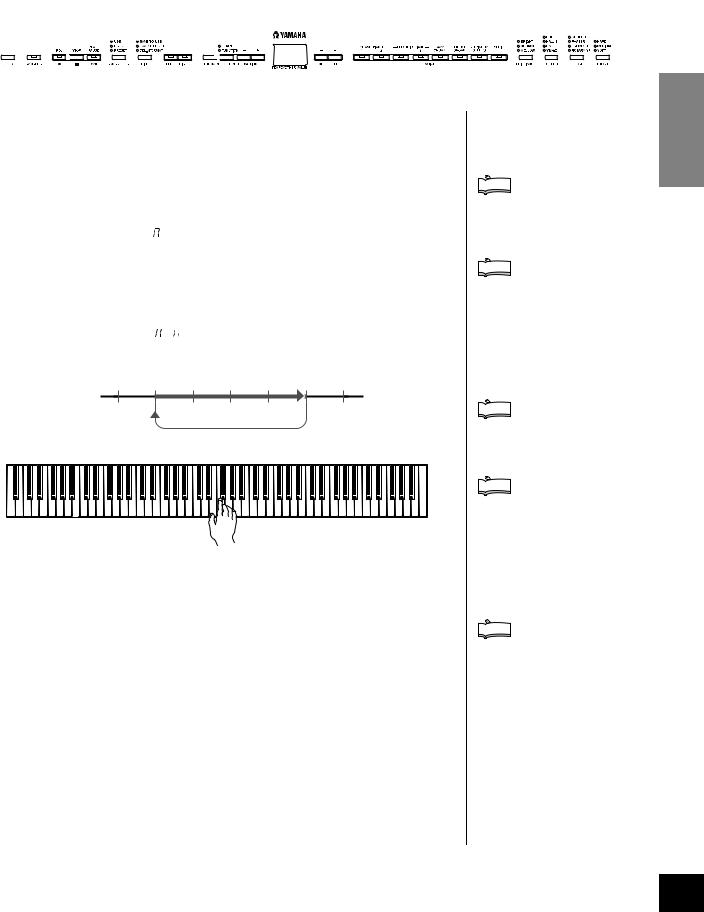
Using the 50 Piano “Preset” Songs
 A-B Repeat for the 50 Preset Songs
A-B Repeat for the 50 Preset Songs
The A-B Repeat function can be used to continuously repeat a specified phrase within a preset song. Combined with the Part Cancel function (page 14), this provides an excellent way to practice difficult phrases.
4 |
2 3 |
|
|
|
|
|||||
|
|
|
|
|
|
|
|
|
|
|
|
|
|
|
|
|
|
|
|
|
|
|
|
|
|
|
|
|
|
|
|
|
|
|
|
|
|
|
|
|
|
|
|
|
|
|
|
|
|
|
|
|
|
|
1. Select and play a preset song.
2. Press the [TEMPO/FUNCTION] button at the beginning of the phrase you want to repeat.
This sets the “A” point ( |
|
will appear on the display). |
3. Press the [TEMPO/FUNCTION] button a second time at the end of the phrase.
This sets the “B” point ( |
|
will appear on the display). |
At this point, repeat playback will begin between the specified A and B points.
A B
Repeat A through B
4. Press the [STOP] button to stop playback.
A-B repeat playback will resume if you press the [PLAY/PAUSE] button.
To cancel the A and B points, press the [TEMPO/FUNCTION] button once.
 NOTE
NOTE
The A-B Repeat function cannot be used during “ALL” or “rnd” (page 13) playback.
 NOTE
NOTE
•To set the “A” point at the very beginning of the song, press the [TEMPO/FUNCTION] button before starting playback.
•You can have the B point automatically be set to the song’s end, by setting the A point and letting the song play to the end.
 NOTE
NOTE
An automatic lead-in (to help guide you into the phrase) starts at the A point of the song.
 NOTE
NOTE
After setting the A and B points, you can set the Sync Start (page 14) and Pedal Play/Pause (page 14) functions.
 NOTE
NOTE
The A and B points are automatically canceled when a new song is selected.
ENGLISH
P-155 Owner’s Manual 15
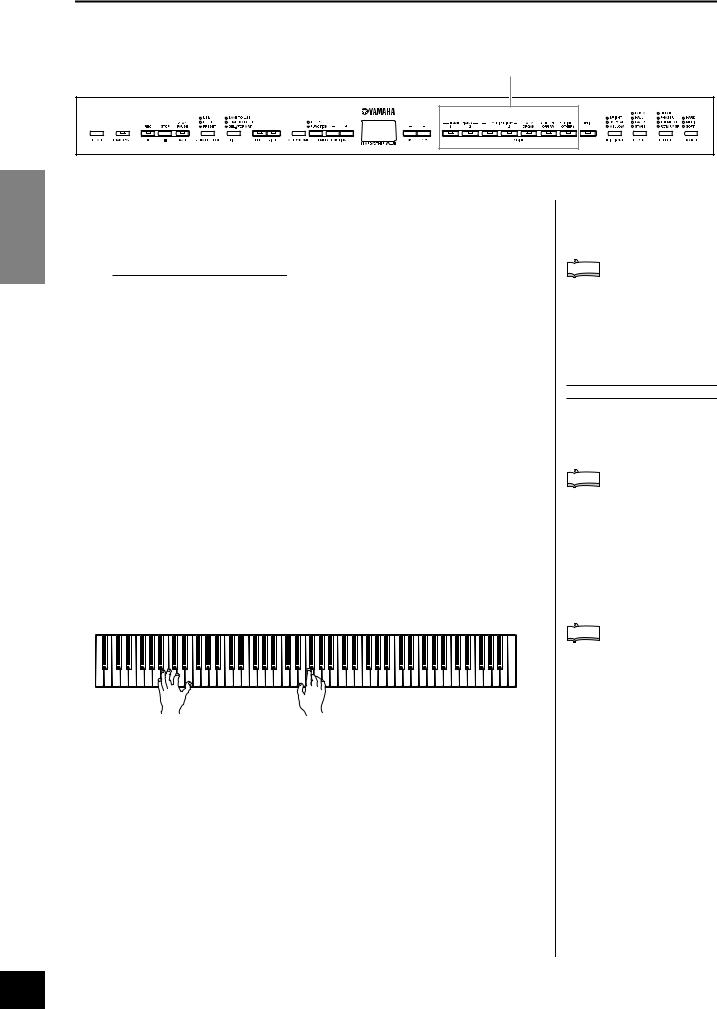
Selecting & Playing Voices
Selecting & Playing Voices
 Selecting Voices
Selecting Voices
Voice Name
ENGLISH
Select the desired voice by pressing one of the Voice buttons.
[STRINGS/OTHERS] button
Pressing the [STRINGS/OTHERS] button switches among the following eleven voices.
Display |
Voice Name |
o 1 |
STRINGS 1 |
|
|
o 2 |
STRINGS 2 |
|
|
o 3 |
CHURCH ORGAN 2 |
|
|
o 4 |
HARPSICHORD |
|
|
o 5 |
E.CLAVICHORD |
|
|
o 6 |
VIBRAPHONE |
|
|
o 7 |
CHOIR |
|
|
o 8 |
GUITAR |
|
|
o 9 |
WOOD BASS |
|
|
o10 |
BASS & CYMBAL |
|
|
o11 |
E.BASS |
|
|
Then, when you start playing, re-adjust the [MASTER VOLUME] dial for the most comfortable listening level.
 NOTE
NOTE
To familiarize yourself with the characteristics of the voices, listen to the demo songs for each voice (page 12). Refer to “Preset Voice List” on page 57 for more information on the characteristics of each preset voice.
TERMINOLOGY
Voice:
On the instrument, the term “voice” means “instrument sound.”
 NOTE
NOTE
You can control the loudness of a voice by adjusting the force with which you strike the keys, although different playing styles (touch sensitivities) have little or no effect with certain musical instruments.
Refer to “Preset Voice List” on page 57.
 NOTE
NOTE
If you select the voice via the
[STRINGS/OTHERS] button then press another VOICE button, the voice last selected via the
[STRINGS/OTHERS] button will be maintained. In other words, pressing the [STRINGS/OTHERS] button again calls up the last selected voice.
16 P-155 Owner’s Manual
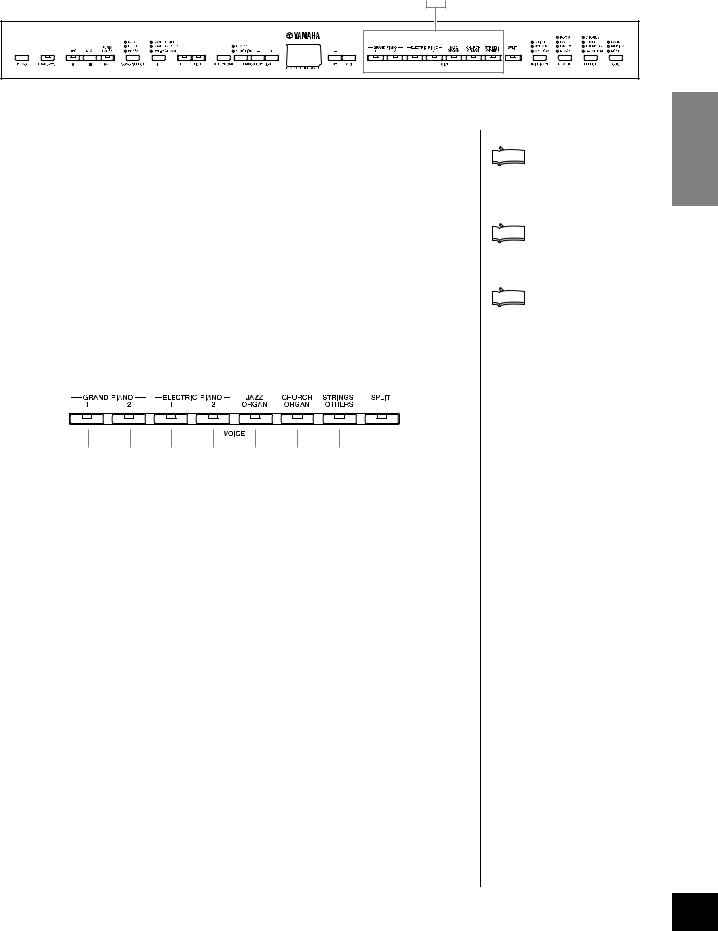
Selecting & Playing Voices
 Combining Voices (Dual)
Combining Voices (Dual)
You can play voices simultaneously across the entire range of the keyboard. In this way, you can combine similar voices to create a thicker sound.
1 2
1. Press two voice buttons at the same time (or press one voice button while holding another) to engage Dual.
The voice indicators of both selected voices will light when Dual is active. Play the keyboard.
If you want to use a voice selected via the [STRINGS/OTHERS] button, press the [STRINGS/OTHERS] button several times to call up the desired voice while holding any other VOICE button. The number of the voice name of the [STRINGS/OTHERS] button is displayed on screen.
According to the voice numbering priority shown in the diagram below, the lower value voice number will be designated as Voice 1 (the other voice will be designated as Voice 2).
Voice numbering priority
1 |
2 |
3 |
4 |
5 |
6 |
7 |
The Function provides access to a number of other Dual functions, such as volume balance setting and octave setting (pages 39, 41). (If you do not set the Dual functions, the appropriate setting will be set in each voice by default.)
2. Press any single voice button to return to the normal single-voice play.
 NOTE
NOTE
Two voices in the [STRINGS/ OTHERS] button cannot be engaged at the same time.
 NOTE
NOTE
Dual and Split cannot be engaged at the same time.
 NOTE
NOTE
[REVERB] in Dual:
The reverb type assigned to Voice 1 will take priority over the other. (If the reverb is set to OFF, Voice 2 reverb type will be in effect.)
[EFFECT] in Dual:
Depending on the condition, one effect type may take priority over the other. The depth is determined according to the default depth value of the voice combination. However, using function F3 (page 41) you can adjust the depth value for each voice to your liking.
ENGLISH
P-155 Owner’s Manual 17

Selecting & Playing Voices
 Splitting the Keyboard Range and Playing Two Different Voices ([SPLIT])
Splitting the Keyboard Range and Playing Two Different Voices ([SPLIT])
Split enables you to play two different voices on the keyboard — one with the left hand and another with the right hand. For example, you can play a bass part using the Wood Bass or Electric Bass voice with the left hand, and a melody with the right hand.
Split point (default setting: F#2)
ENGLISH
Bass voice |
Melody |
3 |
1 2 4 5 |
|||||||||||
|
|
|
|
|
|
|
|
|
|
|
|
|
|
|
|
|
|
|
|
|
|
|
|
|
|
|
|
|
|
|
|
|
|
|
|
|
|
|
|
|
|
|
|
|
|
|
|
|
|
|
|
|
|
|
|
|
|
|
|
|
|
|
|
|
|
|
|
|
|
|
|
|
|
|
|
|
|
|
|
|
|
|
|
|
|
|
|
|
|
|
1. Press the [SPLIT] button to engage Split.
The [SPLIT] button lights.
As a default setting, WOOD BASS will be selected for the left-hand part.
The Function provides access to a number of other Split functions (pages 39, 42). (If you make no settings for the Split functions, the appropriate setting will be set in each voice by default.)
2. Specify the split point (the border between the rightand left-hand range).
Press and hold down the [SPLIT] button and play the key you wish to assign as the split point.
(The split point is initially set at the F#2 key by default. If you do not need to change the split point, skip this step.) You can check the name of the current split point key on the LED display by holding down the [SPLIT] button.
An example of split-point key display
F 2
followed by a high bar if sharp
F#2
Eb2
followed by a low bar if flat
 NOTE
NOTE
Dual and Split cannot be engaged at the same time.
TERMINOLOGY
Default setting:
The “Default setting” refers to the factory setting obtained when you first turn on the power to the instrument.
 NOTE
NOTE
A specified “split point” key is included in the left-hand range.
 NOTE
NOTE
The split point can also be set by the Function F4.1 (page 42).
 NOTE
NOTE
The split point can also be changed by simultaneously holding down the [SPLIT] button and pressing the [–/NO] or [+/YES] button.
The default split point can be recalled by simultaneously holding down the [SPLIT] button and pressing both the [–/NO] and [+/ YES] buttons together.
18 P-155 Owner’s Manual

3. Press a voice button to select a voice for the right hand.
If you want to use a voice selected via the [STRINGS/OTHERS] button, press the [STRINGS/OTHERS] button several times to call up the desired voice. The voice number of the [STRINGS/OTHERS] button is displayed on screen.
4. Press the corresponding voice button while holding the [SPLIT] button to select a voice for the left hand.
The indicator of the left voice button will light while the [SPLIT] button is pressed.
If you want to use a voice selected via the [STRINGS/OTHERS] button, press the [STRINGS/OTHERS] button several times to call up the desired voice while holding the [SPLIT] button. The voice number of the [STRINGS/OTHERS] button is displayed on screen.
5. Press the [SPLIT] button to return to the normal sin- gle-voice play.
Selecting & Playing Voices
 NOTE
NOTE
[REVERB] in Split
The reverb type assigned to the right voice will take priority over the other. (If the reverb is set to OFF, the left voice’s reverb type will be in effect.) Reverb depth settings made via the panel controls (i.e., pressing the [–/NO] or [+/YES] buttons while holding the [REVERB] button; see page 20) will be applied to both voices.
|
NOTE |
|
|
|
|
[EFFECT] in Split |
ENGLISH |
|
Depending on the conditions, one |
||
effect type will take priority over |
||
the other. The depth will be |
||
decided according to the default |
||
depth value of the voice combina- |
|
|
tion. However, using Function F4 |
|
|
(pages 39, 42) you can change |
|
|
the depth value for each voice as |
|
|
you like. Effect depth settings |
|
|
made via the panel controls (i.e., |
|
|
pressing the [–/NO] or [+/YES] |
|
|
buttons while holding the |
|
|
[EFFECT] button; see page 21) |
|
|
will be applied to the right voice |
|
|
only. |
|
|
P-155 Owner’s Manual 19
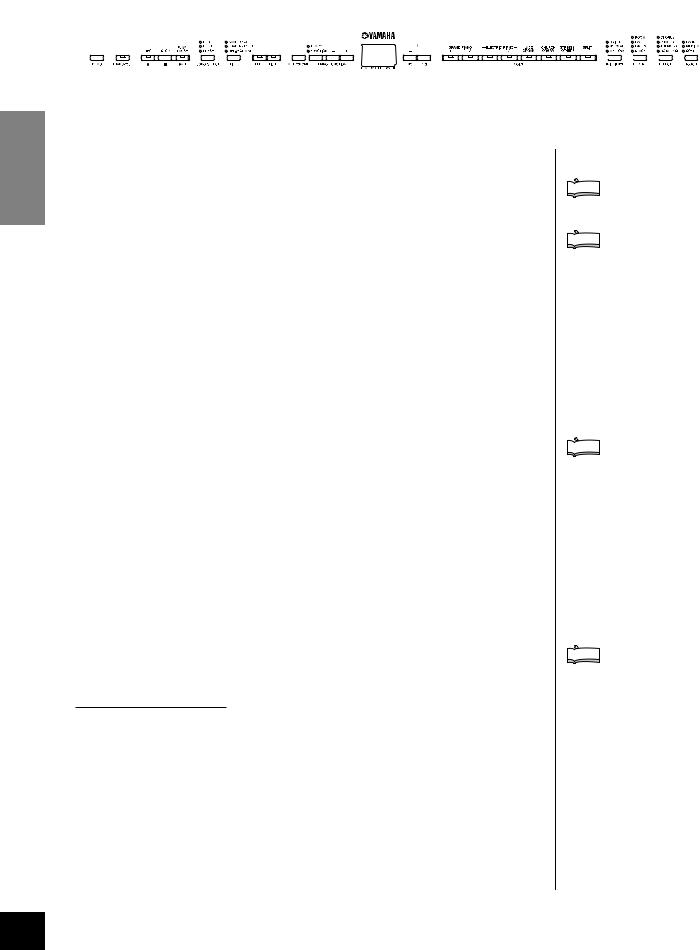
Selecting & Playing Voices
 Adding Variations to the Sound – [BRILLIANCE]/ [REVERB]/[EFFECT]/“Damper Resonance”
Adding Variations to the Sound – [BRILLIANCE]/ [REVERB]/[EFFECT]/“Damper Resonance”
ENGLISH
[–/NO] [+/YES] buttons |
|
[BRILLIANCE] button [EFFECT] button |
|||||||||||
|
|
|
|
|
|
|
|
|
|
|
|
|
|
|
|
|
|
|
|
|
|
|
|
|
|
|
|
|
|
|
|
|
|
|
|
|
|
|
|
|
|
|
|
|
|
|
|
|
|
|
|
|
|
|
|
|
|
|
|
|
|
|
|
|
|
|
|
|
|
|
|
|
|
|
|
|
|
|
|
|
|
|
|
[REVERB] button
[BRILLIANCE]
You can use this control to adjust the brilliance of the tone and change the tonality to suit your preference.
BRIGHT: Bright tone
NORMAL: Standard tone
MELLOW: Soft and mellow tone
To select a brilliance type, press the [BRILLIANCE] button a few times until the indicator corresponding to the desired type lights (the indicator lights in sequence each time you press the [BRILLIANCE] button). Brilliance can be selected among five types. When two adjacent indicators are lit, the type that is between the two indicated types is selected. For example, when both NORMAL and MELLOW are lit, the brilliance setting between NORMAL and MELLOW is selected.
[REVERB]
This control enables you to select various digital reverb effects for adding extra depth and expression to the sound and creating a realistic acoustic ambience.
OFF: When no reverb effect is selected, no REVERB indicator is lit.
ROOM: This setting adds a continuous reverb effect to the sound, similar to the acoustic reverberation you would hear in a room.
HALL 1: For a “bigger” reverb sound, use the HALL 1 setting. This effect simulates the natural reverberation of a small-size concert hall.
HALL 2: For a truly spacious reverb sound, use the HALL 2 setting. This effect simulates the natural reverberation of a large concert hall.
STAGE: Simulates the reverb of a stage environment.
Pressing the [REVERB] button repeatedly toggles the reverb on and off.
The indicators light in sequence each time the [REVERB] button is pressed. When all indicators are off, no effect is produced.
Adjusting Reverb Depth
Adjust the reverb depth for the selected voice by using the [–/NO] [+/YES] buttons while holding the [REVERB] button. Default depth settings are different for each voice. The depth range is from 0 (no effect) through 20 (maximum reverb depth). The current depth setting appears on the display while the [REVERB] button is held.
 NOTE
NOTE
Default setting = NORMAL
 NOTE
NOTE
When the BRILLIANCE is set to BRIGHT, the overall sound will be slightly louder. If the MASTER VOLUME is set at a high level the sound may become distorted. If so, lower the MASTER VOLUME level.
 NOTE
NOTE
The default reverb type (including OFF) and depth settings are different for each voice.
 NOTE
NOTE
Releasing the [REVERB] button changes the reverb type.
If you are changing the reverb depth by holding the [REVERB] button, releasing the [REVERB] button will not change the reverb type.
20 P-155 Owner’s Manual

[EFFECT]
The [EFFECT] button allows you to select an effect to give your sound greater depth and animation.
OFF: When no effect is selected, no EFFECT indicator is lit. CHORUS: A shimmering, broadening effect.
PHASER: Adds a sweeping effect to the sound. TREMOLO: Adds an animated, vibrating effect to the sound. ROTARY SP: Adds the vibrato effect of a rotary speaker.
To select an effect type, press the [EFFECT] button a few times until the indicator corresponding to the desired type lights (the indicators light in sequence each time you press the [EFFECT] button). No effect is produced when all indicators are off.
Adjusting Effect Depth
You can adjust the effect depth for the selected voice by using the [–/NO] and [+/YES] buttons while holding the [EFFECT] button.
Default depth settings are different for each voice. The depth range is from 0 (no effect) through 20 (maximum effect depth). The current depth setting appears on the display while the [EFFECT] button is held.
“Damper Resonance”
The damper resonance lets you hear a simulation of the sustain sound of the damper pedal on a grand piano, as you press the damper pedal and play the keyboard.
This effect is applied to the voice you play on the keyboard and the part (channel 1 & 2.)
Switching Damper Resonance Effect On or
Off and Adjusting Damper Resonance Effect Depth
You can switch the “Damper Resonance” effect on or off via F5.8 Damper Resonance Effect ON/OFF (page 43) in Function and set damper resonance depth via F5.9 Damper Resonance Effect Depth (page 43) in Function.
Selecting & Playing Voices
 NOTE
NOTE
The default effect type (including OFF) and depth settings are different for each voice.
|
NOTE |
|
|
Releasing the [EFFECT] button |
|
||
|
|||
changes the effect type. |
ENGLISH |
||
If you are changing the depth set- |
|||
|
|||
tings by holding the [EFFECT] |
|
||
button, releasing the [EFFECT] |
|
||
button will not change the effect |
|
||
type. |
|
||
|
|
|
|
P-155 Owner’s Manual 21

Selecting & Playing Voices
 Touch Sensitivity – [TOUCH]
Touch Sensitivity – [TOUCH]
[–/NO] [+/YES] buttons |
[TOUCH] button |
||||||||
|
|
|
|
|
|
|
|
|
|
|
|
|
|
|
|
|
|
|
|
|
|
|
|
|
|
|
|
|
|
|
|
|
|
|
|
|
|
|
|
|
|
|
|
|
|
|
|
|
|
|
|
|
|
|
|
|
|
|
|
ENGLISH
[TOUCH]
You can select four different types of keyboard touch sensitivity — HARD, MEDIUM, SOFT or FIXED — to match different playing styles and preferences.
HARD: Requires that the keys be played quite hard to produce maximum loudness.
MEDIUM: Produces a fairly “standard” keyboard response.
SOFT: Allows maximum loudness to be produced with relatively light key pressure.
FIXED: All notes are produced at the same volume no matter how hard the keyboard is played. (No indicators are lit.) The fixed volume can be changed.
To select a touch sensitivity type press the [TOUCH] button a few times until the indicator corresponding to the desired type lights (the indicators light in sequence each time the [TOUCH] button is pressed). No indicator is lit when “FIXED” is selected.
Changing the volume when FIXED is selected
When you select FIXED, you can set the volume for notes played in FIXED by using the [–/NO] and [+/YES] buttons while you hold the [TOUCH] button. The current volume level appears on the display. The volume range is from 1 (minimum volume) through 127 (maximum volume). The default setting is 64.
Volume range
 NOTE
NOTE
This setting does not change the weight of the keyboard.
 NOTE
NOTE
Default setting = MEDIUM
 NOTE
NOTE
The touch sensitivity type will become the common setting for all voices. However, the touch sensitivity settings may have little or no effect with certain voices that are not normally responsive to keyboard dynamics. (Refer to the “Preset Voice List” on
page 57.)
 NOTE
NOTE
The touch volume set in FIXED will become the common setting for all voices.
 NOTE
NOTE
Releasing the [TOUCH] button changes the touch type.
If you are changing the volume by holding the [TOUCH] button, releasing the [TOUCH] button will not change the touch sensitivity type. (FIXED will remain selected.)
22 P-155 Owner’s Manual
